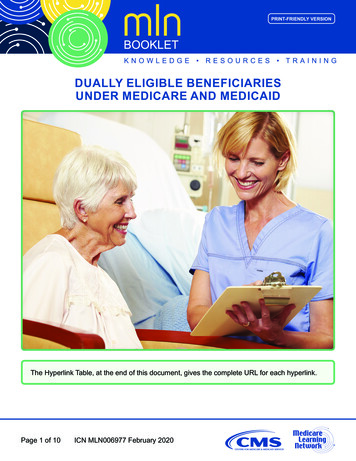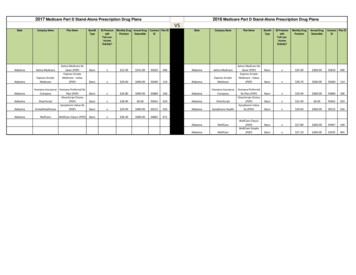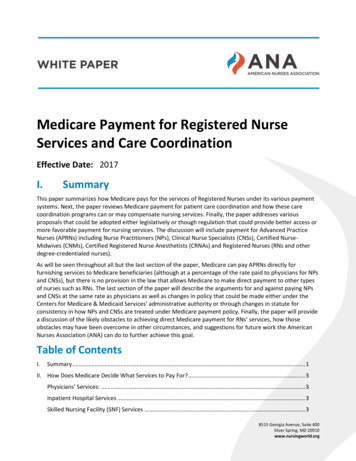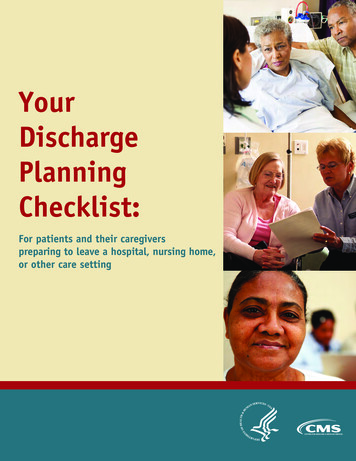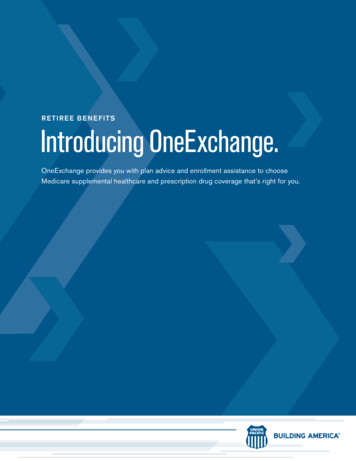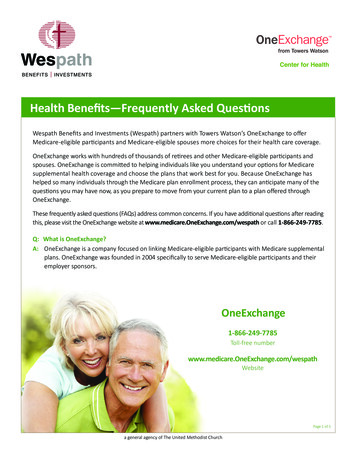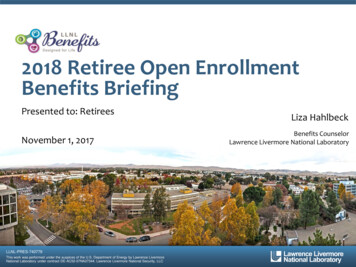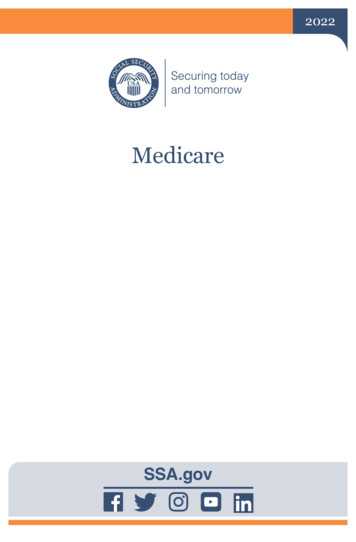
Transcription
2022MedicareSSA.gov
What’s insideMedicare1What is Medicare?1Who can get Medicare?3Rules for higher-income beneficiaries7Medicare Savings Programs (MSP)8Signing up for Medicare9Choices for receiving health services16If you have other health insurance16Contacting Social Security19
MedicareThis booklet provides basic information about Medicarefor anyone who’s covered and some of the optionsavailable when choosing Medicare coverage. Youcan visit Medicare.gov or call the toll-free number1-800-MEDICARE (1-800-633-4227) or the TTY number1-877-486-2048 for the latest information about Medicare.What is Medicare?Medicare is our country’s federal health insuranceprogram for people age 65 or older. People younger thanage 65 with certain disabilities, permanent kidney failure,or amyotrophic lateral sclerosis (Lou Gehrig’s disease),can also qualify for Medicare. The program helps withthe cost of health care, but it doesn’t cover all medicalexpenses or the cost of most long-term care. You havechoices for how you get Medicare coverage. If you chooseto have Original Medicare (Part A and Part B) coverage,you can buy a Medicare Supplement Insurance (Medigap)policy from a private insurance company. Medigapcovers some of the costs that Medicare does not, such ascopayments, coinsurance, and deductibles. If you chooseMedicare Advantage, you can buy a Medicare-approvedplan from a private company that bundles your Part A,Part B, and usually prescription drug coverage (Part D)into one plan.Although the Centers for Medicare & Medicaid Services(CMS) is the agency in charge of the Medicare program,Social Security processes your application for OriginalMedicare (Part A and Part B). We can also give yougeneral information about the Medicare program.We can also help you get a replacement Medicare card.Notify us timely of address changes, name changes,and deaths.1
Parts of MedicareSocial Security enrolls you in Original Medicare (Part Aand Part B). Medicare Part A (hospital insurance) helps coverinpatient care in hospitals (including critical accesshospitals) and skilled nursing facilities (not custodialor long-term care). Part A also pays for some homehealth care and hospice care and inpatient care in areligious non-medical health care institution. Medicare Part B (medical insurance) helps covermedically necessary doctors’ services, outpatient care,home health services, durable medical equipment,mental health services, and other medical services.Part B also covers many preventative services.Other parts of Medicare are run by private insurancecompanies that follow rules set by Medicare. Supplemental (Medigap) policies help pay Medicareout-of-pocket copayments, coinsurance, anddeductible expenses. Medicare Advantage Plan (previously known asPart C) includes all benefits and services coveredunder Part A and Part B, plus prescription drugs andadditional benefits such as vision, hearing, and dental,bundled together in one plan. Medicare Part D (Medicare prescription drug coverage)helps cover the cost of prescription drugs.You can sign up for Original Medicare (Part A and Part B)through Social Security’s online Medicare application.Visit Medicare’s website, Medicare.gov, to get moreinformation about Original Medicare, Medicare Advantage,or Part D coverage; or to download a copy of thepublication Medicare & You (Publication No. CMS-10050).You can also call the Medicare toll-free number at1-800-633-4227; TTY users can call 1-877-486-2048.2
A word about MedicaidMedicaid and Medicare are two different programs.Medicaid is a state-run program that provides hospitaland medical coverage for people with low income. Eachstate has its own rules about who’s eligible and whatMedicaid covers. Some people qualify for both Medicareand Medicaid. For more information about the Medicaidprogram, contact your local medical assistance agency,social services office, or get state contact informationat www.Medicaid.gov.Who can get Medicare?Medicare Part A (hospital insurance)People age 65 or older, who are citizens or permanentresidents of the United States, are eligible for MedicarePart A. You’re eligible for Part A at no cost at age 65 ifone of the following applies: You receive or are eligible to receive benefits fromSocial Security or the Railroad Retirement Board (RRB). Your spouse (living or deceased, including divorcedspouses) receives or is eligible to receive SocialSecurity or RRB benefits. You or your spouse worked long enough in agovernment job through which you paid Medicare taxes. You are the dependent parent of a fully insureddeceased child.If you don’t meet these requirements, you may be ableto get Medicare Part A by paying a monthly premium.Usually, you can purchase this coverage only duringdesignated enrollment periods.NOTE: Even though the full retirement age for SocialSecurity is no longer 65, you should sign up for Medicarethree months before your 65th birthday. You can applyat www.ssa.gov.3
Before age 65, you are eligible for Medicare Part A at nocost if one of the following applies: You’ve been entitled to Social Security DisabilityInsurance (SSDI) benefits for 24 months. You receive a disability pension from the RRB andmeet certain conditions. You receive SSDI benefits because you have LouGehrig’s disease (amyotrophic lateral sclerosis). You worked long enough in a government job throughwhich you paid Medicare taxes and have met therequirements of the SSDI program for 24 months. You’re the child or widow(er) age 50 or older, includinga divorced widow(er), of a worker who has worked longenough under Social Security or in a Medicare-coveredgovernment job, and you meet the requirements of theSSDI program. You have permanent kidney failure (end-stage renaldisease) and you receive maintenance dialysis or akidney transplant and one of the following applies:—You’re eligible for or receive monthly benefits underSocial Security or the railroad retirement system.—You’ve worked long enough in a Medicare-coveredgovernment job.—You’re the child or spouse (including a divorcedspouse) of a worker (living or deceased) who hasworked long enough under Social Security or in aMedicare-covered government job.Medicare Part B (medical insurance)Anyone who’s eligible for Medicare Part A at no costcan enroll in Medicare Part B by paying a monthlypremium. Some people with higher incomes willpay a higher monthly Part B premium. For more4
information, visit our webpage Medicare Premiums:Rules for Higher Income Beneficiaries or f you’re not eligible for Part A at no cost, you can buyPart B without having to buy Part A. You must be age 65or older and one of the following: A U.S. citizen. A lawfully admitted noncitizen who has lived in theUnited States for at least five years.You can only sign up for Part B during designatedenrollment periods. If you don’t enroll in Part B when you’refirst eligible for it, you may have to pay a late enrollmentpenalty for as long as you have Part B coverage. Read the“Signing up for Medicare” section for more information.Medicare Advantage plansIf you receive your Part A and Part B benefits directlyfrom the government, you have Original Medicare. Ifyou receive your benefits from a Medicare Advantageorganization or other private company approved byMedicare, you have a Medicare Advantage plan. Many ofthese plans provide extra coverage and may lower yourout-of-pocket costs.If you have Medicare Parts A and B, you can join aMedicare Advantage plan. With these plans, you can’thave a Medigap policy, because Medicare Advantageplans cover many of the same benefits a Medigap policycovers. This includes benefits like extra days in thehospital after you’ve used the days that Medicare covers.Medicare Advantage plans include all of the following: Health Maintenance Organization (HMO) plans. Preferred Provider Organization (PPO) plans. Private Fee-for-Service (PFFS) plans. Special Needs Plans (SNPs).5
If you decide to join a Medicare Advantage plan, youuse the health card that you get from your MedicareAdvantage plan provider for your health care. Also, youmight have to pay a monthly premium for your MedicareAdvantage plan because of the extra benefits it offers.You can enroll in a Medicare Advantage plan during yourInitial Enrollment Period (IEP), as explained under the“Signing up for Medicare” section, the first time you’reeligible for Medicare. You can also enroll during theannual Medicare open enrollment period from October15 to December 7 each year. The effective date forthe enrollment is January 1 of the following year. Forexample, if you signed up on November 8, 2021, yourcoverage would become active on January 1, 2022. Thereare also special enrollment periods for some situations.Medicare Part D (Medicare prescriptiondrug coverage)Anyone who has Original Medicare (Part A or Part B)is eligible for Medicare prescription drug coverage(Part D). Part D benefits are available as a standalone plan or built into Medicare Advantage, unlessyou have a Medicare private fee-for-service (PFFS)plan. The prescription drug benefits work the same ineither plan. Joining a Medicare prescription drug planis voluntary and you pay an extra monthly premium forthe coverage. Some beneficiaries with higher incomeswill pay a higher monthly Part D premium. For moreinformation, visit our webpage Medicare Premiums:Rules for Higher-Income Beneficiaries, or f you don’t enroll in a Medicare prescription drug planwhen you’re first eligible, you may pay a late enrollmentpenalty if you join a plan later. You’ll have to pay thispenalty for as long as you have Medicare prescriptiondrug coverage. However, you won’t pay a penalty if you6
have Extra Help (see the “Extra Help” section below),or another creditable prescription drug plan. To becreditable, the coverage must pay, on average, at least asmuch as Medicare’s standard prescription coverage.You can enroll during your IEP (as explained under the“Signing up for Medicare” section), the first time you’reeligible for Medicare. You can also enroll during theannual Medicare open enrollment period from October15 to December 7 each year. The effective date for theenrollment is January 1 of the following year. There arealso special enrollment periods for some situations.Rules for higher-income beneficiariesIf you have higher income, the law requires an adjustmentto your monthly Medicare Part B (medical insurance)and Medicare prescription drug coverage premiums.We call the additional amount the income-relatedmonthly adjustment amount. This affects less than 5%of people with Medicare, so most people don’t pay ahigher premium.If you’re single and your income is above 91,000,or married with an income above 182,000, you areconsidered to be a higher-income beneficiary. For moreinformation, visit our webpage Medicare Premiums:Rules for Higher Income Beneficiaries.Monthly Medicare premiums for 2022The standard Part B premium for 2022 is 170.10. Ifyou’re single and filed an individual tax return, or marriedand filed a joint tax return, our online chart applies toyou, regardless of your income. If you disagree with thedecision about your income-related monthly adjustmentamounts, you have the right to appeal. You can find moreinformation on our webpage Medicare Premiums: Rulesfor Higher Income Beneficiaries.7
Medicare Savings Programs (MSP)If you can’t afford to pay your Medicare premiums and othermedical costs, you may be able to get help from your state.States offer Medicare Savings Programs for people entitledto Medicare who have limited income. Some programsmay pay for Medicare premiums and some pay Medicaredeductibles and coinsurance. To qualify, you must haveMedicare Part A and have limited income and resources.You can go online to get more information aboutthese programs from Medicare’s website by visitingMedicare.gov. Find the link titled, “Get Medicare costs”and go to “Get help paying costs.” You can also readGet Help With Your Medicare Costs: Getting Started(Publication No. CMS-10126).Only your state can decide if you qualify for help underthese programs. To find out, contact your state or localmedical assistance (Medicaid) agency, social services,or welfare office.Extra HelpYou may also be able to get Extra Help paying for themonthly premiums, annual deductibles, and prescriptionco-payments related to the Medicare prescription drugprogram. You may qualify for Extra Help if you havelimited resources and income (tied to the federal povertylevel). These resources and income limits usually changeeach year. You can check for the current numbers atwww.ssa.gov/extrahelp.You automatically qualify and don’t need to apply forExtra Help if you have Medicare and meet one of thefollowing conditions: Have full Medicaid coverage. Have Supplemental Security Income (SSI).8
Take part in a state program that pays yourMedicare premiums.For more information about getting help with yourprescription drug costs or to apply for Extra Help, visit usat www.ssa.gov/extrahelp. You can also contact us formore information.Signing up for MedicareWhen should I apply?If you live in Puerto Rico, you don’t automatically get Part B.You must sign up for it. See “Initial Enrollment Periodfor Part B” below for more information or read Medicare inPuerto Rico (Publication No. 05-10521).Some People Get Part A and Part B AutomaticallyIf you’re already getting benefits from us or the RRB,you’ll automatically be enrolled in both Part A and PartB starting the first day of the month you turn 65. If yourbirthday is on the first day of the month, Part A and PartB will start the first day of the prior month. If you’re under65 and have a disability, you’ll automatically get Part Aand Part B after you get disability benefits from SocialSecurity for 24 months. Also, you’ll automatically get PartA and Part B after you get certain disability benefits fromthe RRB. If you have ALS, you’ll get Part A and Part Bautomatically the month your Social Security disabilitybenefits begin.NOTE: Medicare Part B is voluntary and you must pay apremium if you decide you want the coverage.9
If You Are 65 and Not Getting Social Security orRailroad Retirement BenefitsIf you’re not already getting benefits, you should contactus about three months before your 65th birthday to signup for Medicare. You should sign up for Medicare even ifyou don’t plan to retire at age 65.However, if you are eligible for Medicare and your medicalinsurance coverage is through a current employer’sgroup health plan, Medicare has a Special EnrollmentPeriod (SEP) to sign up for Medicare Part B. This SEPqualifies you to delay enrolling in Medicare Part B withouthaving to wait for a General Enrollment Period (GEP) andpaying the penalty for late enrollment. You can find moreinformation, under the section titled “Special EnrollmentPeriod for people covered under an employer grouphealth plan.”Getting Your Medicare CardAfter you enroll in Medicare, you’ll receive a red, white,and blue Medicare card showing whether you havePart A, Part B, or both. Keep your card in a safe placeso you’ll have it when you need it. If your card is lostor stolen, you can request a replacement card onlineby setting up a personal my Social Security account atwww.ssa.gov/myaccount, or call our toll-free numberat 1-800-772-1213, TTY 1-800-325-0778. You’ll alsoreceive Medicare & You (Publication No. CMS-10050),a handbook that describes your Medicare benefits andplan choices.Other enrollment situationsYou should also contact us about applying for Medicare ifone of the following applies: You’re a widow or widower with a qualifying disabilityand between age 50 and age 65, but haven’t applied10
for disability benefits because you’re already gettinganother kind of Social Security benefit.You’re a government employee and have a disabilitythat occurred before age 65.You, your spouse, or your dependent child haspermanent kidney failure.You had Medicare Part B in the past, but droppedthe coverage.You turned down Medicare Part B when you firstgot Part A.You or your spouse worked for the railroad industry.Initial Enrollment Period for Part BIf you are already getting benefits from Social Securityor the RRB, you will automatically get Part A and Part Bstarting on the first day of the month when you turn 65. Ifyour birthday is on the first day of the month, Part A andPart B will start the first day of the prior month.You will need to choose which way to get your Medicarehealth coverage: Original Medicare — includes Part A and Part B.You can buy supplemental coverage from a privatecompany to help pay your out-of-pocket costs. You canalso add Medicare drug coverage (Part D). Medicare Advantage — a Medicare-approved plan froma private company that bundles your Part A, Part B,and usually drug coverage (Part D) into one plan. Mostplans include extra benefits like vision, hearing, dental,and more.If you’re under 65 and have a disability, you’llautomatically get Part A and Part B after you get SSDIbenefits or certain disability benefits from the RRB after24 months.11
If you are not receiving Social Security or RailroadRetirement benefits at age 65, you can first sign up forPart A or Part B (together or individually) during the sevenmonth period that begins three months before the monthyou turn 65. This period includes the month you turn 65and ends three months after the month you turn 65.NOTE: If you don’t enroll in Part B when you’re first eligiblefor it, you may have to pay a late enrollment penalty for aslong as you have Part B coverage. Also, you may have towait to enroll, which will delay this coverage.When does my enrollment in Part Bbecome effective?If you accept the automatic enrollment in Medicare Part B orif you enroll during the first three months of your age 65 IEP,your coverage will start with the month you’re first eligible.If you enroll during the last four months, your coverage willstart from one to three months after you enroll.The following chart shows when your Medicare Part Bbecomes effective:If you enroll in thismonth of your InitialEnrollment PeriodThen your Part BMedicare coverage startsOne to three months before youreach age 65The month you reach age 65The month you reach age 65One month after the month youreach age 65One month after you reachage 65Two months after the monthof enrollmentTwo or three months after youreach age 65Three months after the monthof enrollment12
General Enrollment Period for Part BIf you don’t enroll in Medicare Part B during your IEP, youhave another chance each year to sign up during a GEPfrom January 1 through March 31. Your coverage beginson July 1 of the year you enroll. However, you may haveto pay a late enrollment penalty for as long as youhave Part B coverage. Your monthly premium will goup 10% for each 12-month period you were eligible forPart B, but didn’t sign up for it.Medicare Advantage Open Enrollment Period forpeople leaving Medicare Advantage planIf you’re in a Medicare Advantage plan, you can leavethat plan and switch to Original Medicare from January1 through March 31. If you use this option, you alsohave until March 31 to join a Medicare Part D (Medicareprescription drug plan). Your coverage begins the first dayof the month after the plan gets your enrollment form.Special Enrollment Period for people coveredunder an employer group health planIf you’re 65 or older and covered under a group healthplan, either from your own or your spouse’s currentemployment, you may sign up for Medicare Part B duringyour SEP. This means that you may delay enrolling inMedicare Part B without having to wait for a GEP andpaying the penalty for late enrollment. There are limits,so we strongly advise you to contact us up to threemonths before your 65th birthday if you are unsure ofyour situation.The SEP rules allow you to do one of the following: Enroll in Medicare Part B any time while you oryour spouse have a group health plan based oncurrent employment.13
Enroll in Medicare Part B during the eight-monthperiod that begins the month after the employmentends or the group health coverage ends, whicheverhappens first.You can’t enroll using an SEP until your age 65 IEPis over. If your employment or the employer-providedgroup health plan coverage ends during your age 65IEP, see the enrollment chart under the “When does myenrollment in Part B become effective?” section.When you enroll in Medicare Part B while you’re still in thegroup health plan, or during the first full month when youare no longer in the plan, your coverage begins in one ofthe following: On the first day of the month you enroll. By your choice, on the first day of any of the followingthree months.If you enroll during any of the remaining seven months ofthe SEP, your Medicare Part B coverage begins on thefirst day of the following month.If you don’t enroll by the end of the eight-month period,you’ll have to wait until the next GEP, which beginsJanuary 1 of the next year. You may also have to pay alate enrollment penalty for as long as you have Part Bcoverage, as described previously.If you get SSDI benefits and have coverage under a largegroup health plan (100 or more employees) from eitheryour own or a family member’s current employment, youmay also have an SEP. If so, you have premium rightssimilar to those for current workers age 65 or older.NOTE: COBRA and retiree health coverage don’t countas current employer coverage.14
Signing up for Part B during the SpecialEnrollment PeriodYou can do one of the following:1. Go to “Apply Online for Medicare Part B During aSpecial Enrollment Period” and complete CMS-40Band CMS-L564. Then, upload your evidence of GroupHealth Plan or Large Group Health Plan.2. Fax your CMS-40B and employer-signed CMS-L564forms to your local Social Security office.3. Mail your CMS-40B and employer-signed CMS-L564to your local Social Security office.NOTE: When completing the CMS-L564: State, “I want Part B coverage to begin (MM/YY)”in the remarks section of the CMS-40B form oronline application. If your employer is unable to complete Section B,please complete that portion as best as you can onbehalf of your employer without your employer’ssignature. Then, submit one of the following forms ofsecondary evidence:—Income tax returns that show health insurancepremiums paid.—W-2s reflecting pre-tax medical contributions.—Pay stubs that reflect health insurancepremium deductions.—Health insurance cards with a policy effective date.—Explanations of benefits paid by the group healthplan or large group health plan.—Statements or receipts that reflect payment of healthinsurance premiums.15
Choices for receiving health servicesMedicare beneficiaries have choices for getting healthcare services.You can get more information about your health carechoices from the following publications: Medicare & You (Publication No. CMS-10050) —CMS mails this guide to people after they enroll inMedicare and sends them an updated version eachyear after that. Choosing a Medigap Policy: A Guide toHealth Insurance for People with Medicare(Publication No. CMS-02110) — This guide describeshow other health insurance plans supplementMedicare and offers some shopping hints for peoplelooking at those plans.To get a copy of these publications, visitMedicare.gov/publications or call the toll-free number,1-800-MEDICARE (1-800-633-4227). If you’re deaf orhard of hearing, call TTY 1-877-486-2048.If you have other health insuranceMedicare Part A (hospital insurance) is free for almosteveryone. You have to pay a monthly premium forMedicare Part B (medical insurance). If you already haveother health insurance when you become eligible forMedicare, is it worth the monthly premium costs to sign upfor Part B?The answer varies with each person and the kind of otherhealth insurance you have. Although we can’t give you“yes” or “no” answers, we can offer information that canhelp you decide. We can also advise if you’ll be subject toa late enrollment penalty if you delay signing up.16
If you have a private insurance planGet in touch with your insurance agent to see how yourprivate plan fits with Medicare Part B. This is especiallyimportant if you have family members who have coverageunder the same policy. And remember, just as Medicaredoesn’t cover all health services, most private plans don’teither. In planning your health insurance coverage, keepin mind that most nursing home care isn’t covered byMedicare or private health insurance policies.NOTE: For your own protection, do not cancel anyhealth insurance you now have until after yourMedicare coverage begins.If you have insurance from an employer-providedgroup health planBy law, group health plans of employers with 20 ormore employees have to offer current workers and theirspouses who are age 65 (or older) the same healthbenefits as younger workers.If you or your spouse are still working and covered underan employer-provided group health plan, talk to thepersonnel office before signing up for Medicare Part B.If you have a Health Savings AccountYou can’t contribute to your Health Savings Account(HSA) once Medicare Part A or Part B coverage begins.However, you may use money that’s already in your HSAafter you enroll in Medicare to help pay for deductibles,premiums, copayments, or coinsurance. If you contributeto your HSA after your Medicare Part A or Part Bcoverage starts, you may have to pay a tax penalty.Remember, premium-free Part A coverage begins sixmonths before the date you apply for Medicare (or SocialSecurity/RRB benefits), but no earlier than the first monthyou were eligible for Medicare. To avoid a tax penalty,17
you should stop contributing to your HSA at least sixmonths before you apply for Medicare. If you are unsureof how Medicare Parts A or B will work with your employercoverage, talk with your employer about your HSA optionsup to six months before you turn age 65.If you have health care protection fromother plansIf you have TRICARE (insurance for active-duty, militaryretirees, and their families), your health benefits canchange or end when you become eligible for Medicare.This applies for any reason, regardless of age or placeof residence. If you’re retired from the military or area military retiree’s family member, you must enroll inPart A and Part B when first eligible to keep TRICAREcoverage. You can find a military health benefits adviserat https://milconnect.dmdc.osd.mil, or call the DefenseManpower Data Center, toll-free at 1-800-538-9552 (TTY1-866-363-2883) before you decide whether to enroll inMedicare Part B.If you have health care protection from the Indian HealthService, Department of Veterans Affairs, or a statemedical assistance program, contact those offices to helpyou decide if it’s to your advantage to have MedicarePart B.IMPORTANT: If you have VA coverage and don’t enrollin Part B when you’re first eligible, you may have to paya late enrollment penalty for as long as you have Part Bcoverage. Also, you may have to wait to enroll, which willdelay this coverage.For more information on how other health insurance planswork with Medicare, visit www.medicare.gov/publicationsto view the booklet Medicare and Other HealthBenefits: Your Guide to Who Pays First18
(Publication No. CMS-02179) or call Medicare’s toll-freenumber, 1-800-MEDICARE (1-800-633-4227). If you’redeaf or hard of hearing, call TTY 1-877-486-2048.Contacting Social SecurityThere are several ways to contact us, such as online,by phone, and in person. We’re here to answer yourquestions and to serve you. For more than 85 years,Social Security has helped secure today and tomorrow byproviding benefits and financial protection for millions ofpeople throughout their life’s journey.Visit our websiteThe most convenient way to conduct Social Securitybusiness is online at www.ssa.gov. You can accomplisha lot. Apply for Extra Help with Medicare prescription drugplan costs. Apply for most types of benefits. Find copies of our publications. Get answers to frequently asked questions.When you create a personal my Social Security account,you can do even more. Review your Social Security Statement. Verify your earnings. Get estimates of future benefits Print a benefit verification letter. Change your direct deposit information. Request a replacement Medicare card. Get a replacement SSA-1099/1042S. Request a replacement Social Security card, if youhave no changes and your state participates.19
Access to your personal my Social Security account maybe limited for users outside the United States.Call usIf you cannot use our online services, we can help you byphone when you call your local Social Security office orour National toll-free 800 Number. You can find your localoffice information by entering your ZIP code on our officelocator webpage.You can call us at 1-800-772-1213 — or at our TTYnumber, 1-800-325-0778, if you’re deaf or hard ofhearing — between 8:00 a.m. – 7:00 p.m., Mondaythrough Friday. Wait times to speak to a representativeare typically shorter Wednesdays through Fridaysor later in the day. We also offer many automatedtelephone services, available 24 hours a day, so you donot need to speak with a representative.If you have documents we need to see, remember thatthey must be original or copies that are certified by theissuing agency.20
Notes21
Social Security Administration Publication No. 05-10043January 2022 (Recycle prior editions)MedicareProduced and published at U.S. taxpayer expense
Signing up for Medicare 9 . or to download a copy of the publication . Medicare & You (Publication No. CMS-10050). You can also call the Medicare toll-free number at . 1-800-633-4227; TTY users can call . 1-877-486-2048. 3 A word about Me

